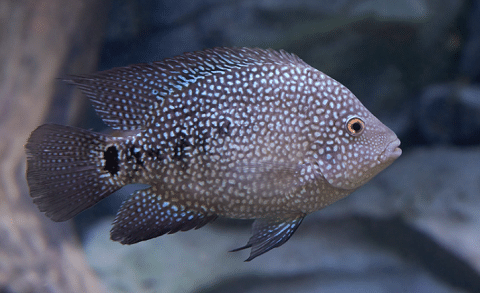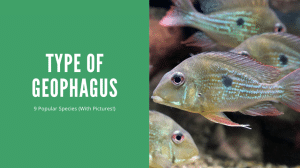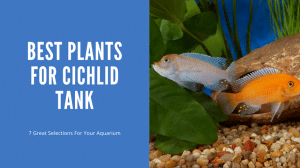Thank you for visiting! By the way… any links on this page that lead to products on Amazon and other stores/partners are affiliate links Aquarium Store Depot earns a commission if you make a purchase.
Enthusiasts are drawn to the world of Texas Cichlids as they provide a unique challenge. These freshwater fish add an interesting sight to any home aquarium, and there’s plenty to learn about what makes them so special. We invite you to come along with us on this journey. Let’s take a look at these amazing creatures!
Key Takeaways
- Texas Cichlids are smart, colorful fish that can live over 10 years with proper care.
- Caring for them requires a 55 gallon tank setup (75 gallon recommended) and maintaining the same conditions as their natural habitat.
- Feeding should include commercial flakes or pellets supplemented with live foods given in small portions twice daily.
- They are very aggressive and need large tankmates who can hold their own
Species Overview
| Scientific Name | Herichthys cyanoguttatus |
| Common Names | Texas Cichlid, Rio Grande Cichlid, Pearl Cichlid |
| Family | Cichlidae |
| Origin | North America (Texas, United States and Northern Mexico) |
| Diet | Omnivorous |
| Care Difficulty | Moderate |
| Activity | Active |
| Life Expectancy | 10-15 Years |
| Temperament | Aggressive |
| Tank Level | All |
| Minimum Tank Size | 55 gallons (208 liters) for a single fish, larger for multiple or if kept with other species. |
| Water Temperature Range | 68-78°F (20 – 25°C) |
| Water Hardness | 5-12 dKH |
| pH Range | 6 – 8 |
| Filtration/Water Flow | Strong |
| Water Type | Freshwater |
| Breeding | Oviparous |
| Difficulty to Breed | Moderate |
| Compatibility | Aggressive tank with similar sized or larger fish |
| OK, for Planted Tanks? | No |
Introduction
The ‘Green Texas Cichlid’ or scientifically Herichthys cyanoguttatus, is a fish species native only to the United States of America and found in the Rio Grande near San Antonio. This particular freshwater fish species has earned its reputation for being rather aggressive. Because of its aggressive nature, it’s not a fish that is suited for beginner aquarists.
Nevertheless, they more than make up these negatives with their savvy abilities- this breed of fish will recognize its owner and often display active behavior when playing around gravel or tearing apart aquascapes. It’s not hard to see why this species stands out: they have brains as much as brawns!
Origin And Distribution
The Rio Grande Perch, also called the Texas Cichlid or Rio Grande Cichlid, originates from the Rio Grande River. With their native environment consisting of a soft sandy base with rocks and aquatic plants beneath its surface in water that is slightly acidic, they prove to be remarkably resilient creatures. They are also located in northeast Mexico – where they are known as popular game fish.
Appearance

These remarkable large fish of the cichlid species can be up to 12 inches in length, dominating any aquarium. They have a mostly dark base, with blue and green colored scales that give it a shiny look. Their shine is complimented by their trademark body shape, comprising an expansive dorsal fin accompanied by a broad lateral line. All these elements define this intimidating type of fish that is unrivaled in beauty!
Types Of Texas Cichlids (And Color Variations)
There are also multiple types of Texas Cichlids available to purchase at pet stores. There is the electric blue Texas Cichlid, which exhibits a glowing blue shade covered with turquoise dots. There is the green Texas Cichlid with mostly green highlights. The most exotic is called the Red Texas Cichlid. This variety is a hybrid of a blood parrot and a classic Texas Cichlid. Usually, this hybrid is created with the help of a female Red Parrot and a male Texas Cichlid.

Lifespan
Texas Cichlids are a valuable addition to an aquarium, as these hardy fish can live for up to 10-15 years if they’re taken care of properly. Regular water changes and a balanced diet are necessary in order to maximize your cichlid’s lifespan – just remember that this isn’t just any short term commitment when it comes to taking on such fish! They live long, and they get large as we will learn below.
Average Size
An Adult Texas Cichlid can reach up to a foot in length, and as such need plenty of swimming space when housed. When deciding on the Texas Cichlid tankmates you would like to choose for your aquarium set-up, it’s advisable that they are similar size and temperament since these larger freshwater fish may tend towards aggression with smaller ones.
A spacious tank is essential if you plan on housing one or more majestic Texas cichlids, while selecting their companions.
Caring For Your Texas Cichlid
Caring for Texas Cichlids is a task that must not be taken lightly. These fish need an environment where they feel comfortable and eat a balanced diet in order to remain healthy. Looking after the tank setup, maintaining clean water with regular changes, as well as feeding them correctly should all receive careful consideration. Let’s go into what it takes to make them thrive.
Tank Requirements
When it comes to maintaining a home for the Texas Cichlid, tank size is critical. At least 55 gallons of space should be allocated for a single Texas Cichlid in order to provide a sufficient swimming area. For a mixed tank, you should go to at least 75 gallons. Going bigger with your aquarium can also improve outcomes related to aggressive behavior. In nature, they establish large territories. If you can manage a 6 or 8 foot long tank, you will typically see less aggression with this fish.
The environment should mimic their natural habitat as much as possible. Adding gravel or sand substrate along with rocks that won’t get tossed around or artificial decor you don’t mind getting trashed around will create plenty of spots where they can hide out when needed. Since this species loves digging into things, live plants are not recommended.
Water Parameters (Living Conditions)
For a Texas Cichlid to be in good health, its environment should match the conditions of its native habitat. The ideal temperature range is between 68-78°F (though they prefer warmer water temperatures around 78-82). They aren’t too picky about pH having a while range of 6 – 8, while water hardness can range from 5-15 dGH. It’s necessary to keep an eye on these parameters so that any sudden alterations do not cause stress for your fish leading to illness or other issues. It’s vital that cleanliness and proper maintenance occur in order for them to remain healthy and contented. To stay on a solid water change schedule, monitor these two major water conditions:
Note once your fish is an adult, it can tolerate a much higher range of nitrates level. However, some other fish you may keep may not be as tolerant or may be younger. There are many documented cases of large, aggressive fish being able to thrive on high nitrates. We provide a best practice to follow, which would be one that we would follow in our own tanks.
Feeding And Nutrition
Texas Cichlids require a balanced diet for their health and well-being. These omnivorous fish are not fussy eaters, consuming various foods such as crustaceans, eggs, insects, and even plant matter. It is essential that they receive high quality nutrition from commercial flakes or pellets supplemented with live food like larvae and worms two times daily in small portions so they do not overeat. Large pellets and frozen food are best as they get larger. You can also feed the live insects once they become adults.
Feeding Schedule
It is essential for Texas Cichlids to maintain a regular feeding schedule. The best approach would be two meals per day in smaller portions to prevent them from overindulging and curb aggression somewhat. Offering a variety of foods to help keep your little Texan friend thriving each and every day.
Texas Cichlid Behavior And Compatibility
Texas Cichlids can be fascinating fish to own due to their active swimming, intelligent behavior, and recognition of owners. They are also known for being quite territorial, which means it is not advisable to keep them in a community tank with docile species, as their aggressive nature will cause problems. To lessen this issue, if you still want Texas cichilds in a tank environment, then keeping similar-sized semi-aggressive or more fierce specimens may help maintain balance amongst those living peacefully.
Ideal Tank Mates

Texas Cichlid tank mates can be kept in if they have the fortitude to tolerate their territorial nature. Other cichlids (usually South American Cichlids), sharing a similar disposition, make good companions for this species. Here are a few solid choices to consider:
- Jack Dempsey
- Red Devils
- Red Parrots
- Jaguar Cichlids
- Oscars
- Green Terror
Note that you shouldn’t purchase a new fish as a tankmate that is smaller than them. If they are too small, they will be eaten, attacked, or even killed. In much larger tanks, it is possible to get away from this, but we are writing this article assuming that most readers are putting them in 4 foot long tanks.
Bad Tank Mates

Keeping Texas Cichlids in the same tank can be troublesome, as they tend to exhibit territorial behavior. It’s important to remember that vulnerable and small species should not join them, these fish may easily become prey. Here are some obvious bad examples:
- All small schooling fish
- Livebearers
- Small bottom feeders like Cory Catfish
- Larger community fish like Angelfish and Discus fish
- Inverts like snails, shrimp, and crabs
It is also not best to keep the same species together unless you manage to get a male and female and they pair up.
Breeding Texas Cichlids
If you’re ready to take on a challenge, Texas Cichlids breeding can be an exhilarating experience. You need to plan out the process accordingly and closely monitor every step for successful results – from installing the aquarium with sand bedding and flat rock, watching their courting dance along with the color change of male cichlid during this ritual. All are part of what makes these fish so captivating! Ensuring proper care in each stage is vital if one wishes to obtain desired outcomes (video source).
Females can be differentiated from females as they get older as the female has a black spot on their dorsal fin. Some males may develop a nuchal hump.
Spawning And Fry Care
Texas Cichlids have a unique spawning process. The pair clear an area, usually on a flat rock or in the substrate, and lay between 500-1000 eggs that are sticky to the touch and are roughly 2 mm in size. They will stay by these until they hatch before transitioning into providing care for their fry once they reach free swimming stages. One thing to keep in mind with Texas Cichlids in a breeding tank is once the fry are born, the male may push his aggression on the female if there are no other tankmates. In a breedin tank situation, it would be best to remove the male once the fry are born or use a tank separator to keep the male away from the female and the fry.
Feeding fry is easy as they are born big enough to eat baby brine shrimp. Feed this and powered flakes until they are big enough to eat traditional aquarium food.
Common Health Issues And Prevention
When owning a Texas Cichlid, there are certain illnesses that can affect it. Fin Rot and Ich are two of the most frequent issues for these fish, requiring special care to prevent or treat. Fin rot usually isn’t a serious condition with these fish, but their weakened state could make them a target.
Keeping an orderly tank environment is key in avoiding injuries as well as providing proper conditions with regard to water temperature stability. This helps create a stress-free atmosphere for your pet cichlids and also reduces their risk of getting Ich.
Injuries are the major thing you will likely deal with aggressive fish. Because they will fight with each other, there is a chance of a severe wound. if this happens, separate the fish and treat it with antibiotics. If treatment does become necessary, then over-the-counter medications should do the trick!
Frequently Asked Questions
Are Texas cichlid rare?
Texas cichlids are quite hard to find in good condition, especially if they reach show quality standards. This makes these specimens rather costly due to the rarity of them being seen available for purchase. Some types, like the Red Texas Cichlid, are considered a rare find in the aquarium trade. The Red Texas Cichlid is the only cichlid species from the Americans that features the color scheme that it displays.
Are Blue Texas cichlids aggressive?
Yes, Electric Blue Texas Cichlids can be quite aggressive, although not as aggressive as some of its Central American relatives. It is important to choose tank mates for them with care to avoid any potential bullying and even killing.
Are Texas cichlids invasive?
Texas cichlids have unfortunately become an invasive species, having been released or discarded into the wild by their owners and now present in Texas, Louisiana, and Florida1. Scientists also note that these fish can be quite territorial when it comes to other aquatic lifeforms, making them a risk to the environment as well. The aggression displayed towards other fish is still being monitored, but its results are already worrisome.
Are Texas Cichlids suitable for beginners?
Due to their aggressive behavior, Texas Cichlids are not recommended for novice aquarists. It’s better to stick to hardy schooling freshwater species or a betta fish if you are considering freshwater fish for the first time. Also, due to their large adult size, they require large tanks, which are outside of the budgets of most beginners.
How big of a tank do I need for a Texas Cichlid?
For your Texas Cichlid, it’s important to get the best living situation possible for them. A tank of 55-gallons is the minimum size that should be provided for a single species. If you can find one with a bigger capacity, this will give your fish more room to swim and explore. It’ll also aid in providing better water quality conditions overall as well! As an added precaution, make sure your tank has all of the necessary filters and heating equipment set up properly so they have just what they need when it comes to temperature regulation too.
Summary
Texas Cichlids, though quite distinct in their physical features and behavior patterns, can be incredibly rewarding for aquarium owners who are willing to provide them with a large tank that meets their specific needs. Having the knowledge of how best to keep these fish makes it all worth while, they captivate viewers with an unmatched presence and prove themselves as much more than just regular old fish when given the right environment!
Do you have a Texas Cichlid? Let us know your experience in the comments below! Thanks for reading and see you next time!
- About the Author
- Latest Posts
I’m thrilled that you found Aquarium Store Depot! Here you’ll find information on fish, aquariums, and all things aquatics related. I’m a hobbyist (being doing this since I was 11) and here to help other hobbyists thrive with their aquariums! I adhere to a high quality Editorial Process and Review products with real life field usage and practical analysis.





